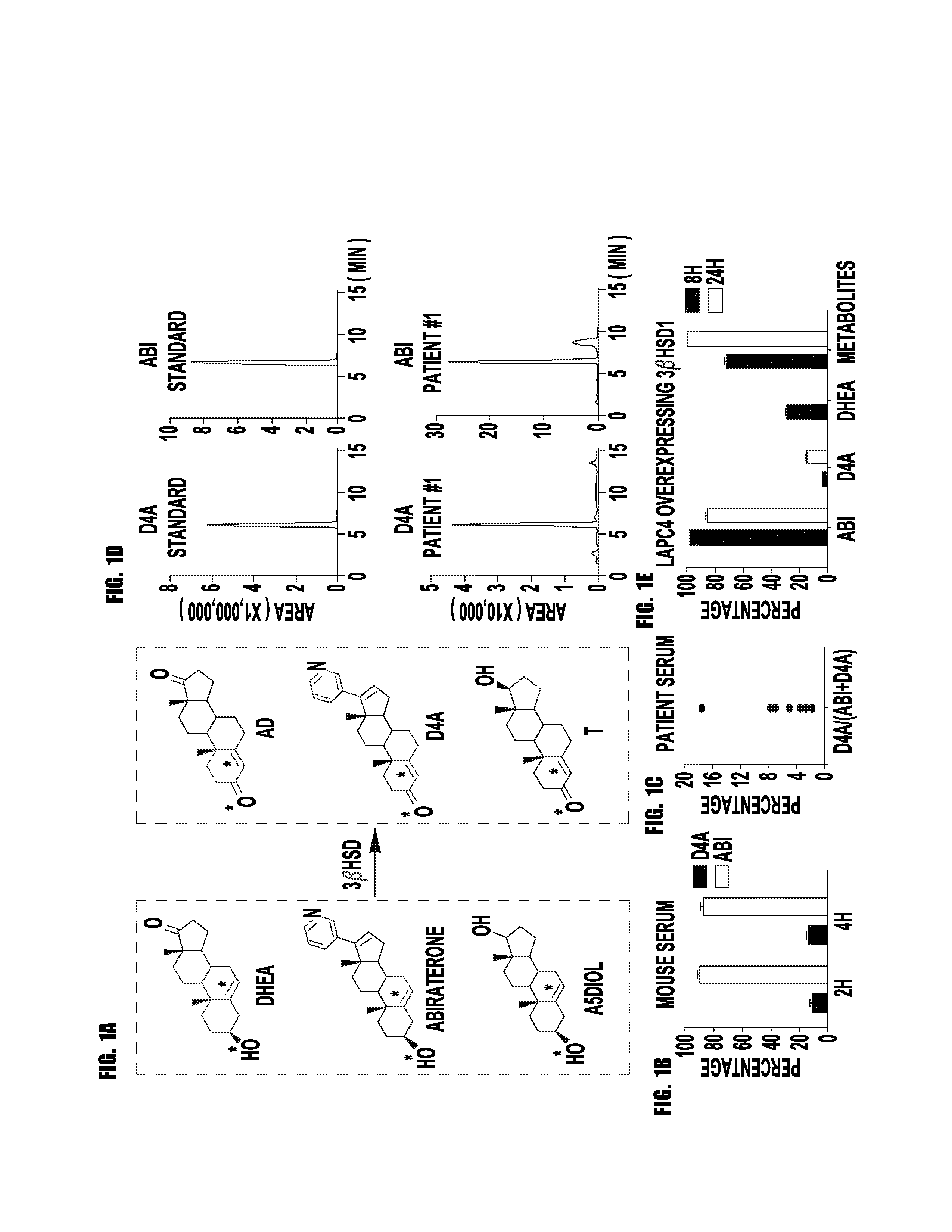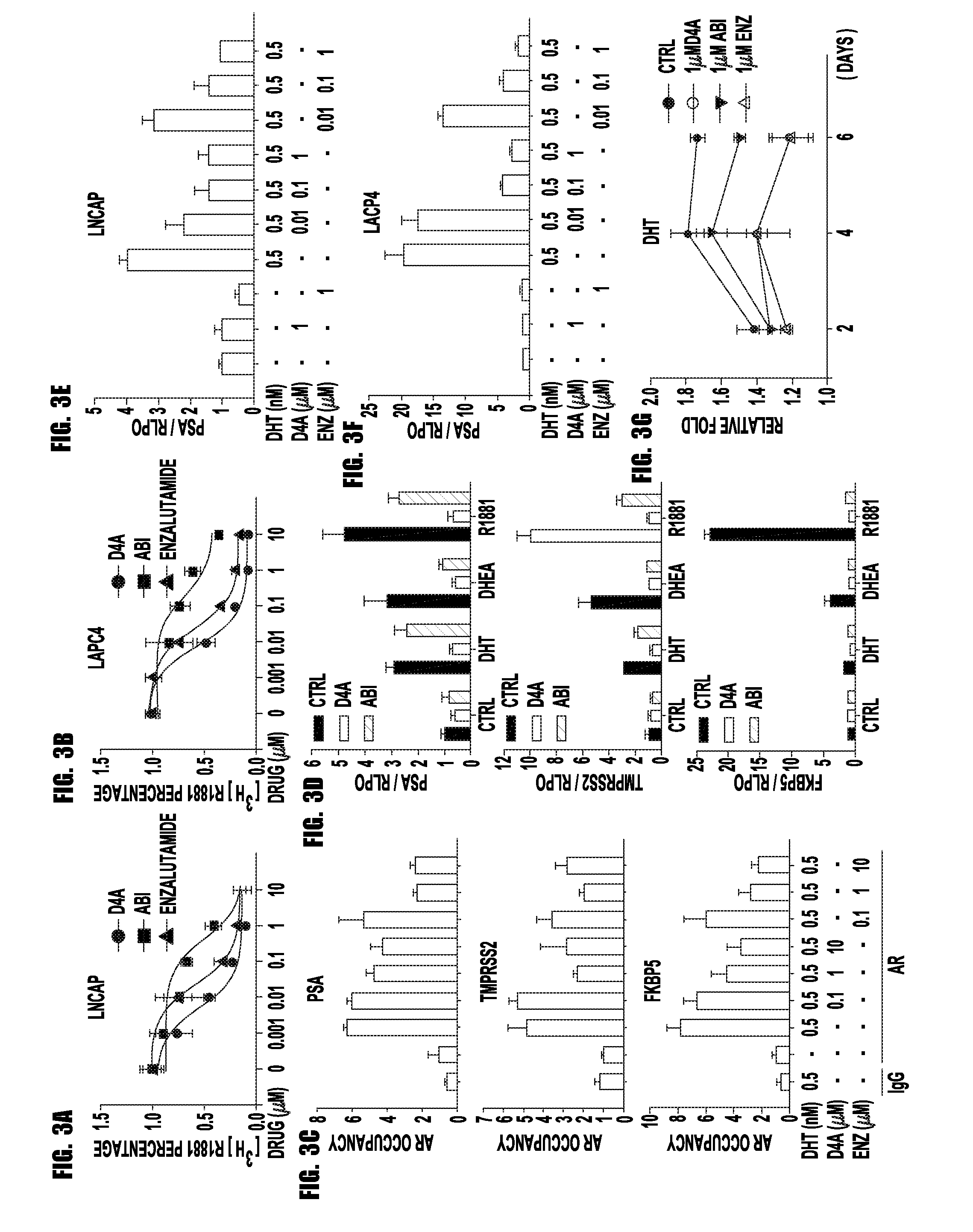Altering steroid metabolism for treatment of steroid-dependent disease
a steroid-dependent disease and metabolism technology, applied in the direction of pharmaceutical delivery mechanism, organic active ingredients, drug compositions, etc., can solve the problems of reductase inhibitors, pharmacological blockage of d4a to 5-abiraterone, etc., and achieve the effect of promoting tumor growth
- Summary
- Abstract
- Description
- Claims
- Application Information
AI Technical Summary
Benefits of technology
Problems solved by technology
Method used
Image
Examples
example 1
Conversion of Abiraterone to D4A Drives Antitumor Activity in Prostate Cancer
[0061]Prostate cancer resistance to castration occurs because tumors acquire the metabolic capability of converting precursor steroids to 5α-dihydrotestosterone (DHT), promoting signaling by the androgen receptor (AR) and the development of castration-resistant prostate cancer (CRPC). Chang et al., Cell, 154:1074-1084 (2013). Essential for resistance, DHT synthesis from adrenal precursor steroids or possibly from de novo synthesis from cholesterol commonly require enzymatic reactions by 3β-hydroxysteroid dehydrogenase (3βHSD), steroid-5α-reductase (SRD5A) and 17β-hydroxysteroid dehydrogenase (17βHSD) isoenzymes. Knudsen K E, Penning T M., Trends Endocrinol Metab. 21:315-324 (2010). Abiraterone, a steroidal 17α-hydroxylase / 17,20-lyase (CYP17A1) inhibitor, blocks this synthetic process and prolongs survival. Ryan et al., N Engl J Med. 368(2):138-48, (2012). We hypothesized that abiraterone is converted by an ...
example 2
Redirecting Abiraterone Metabolism to Biochemically Fine Tune Prostate Cancer Therapy
[0087]Abiraterone is metabolized in patients to D4A, which has even greater anti-tumor activity and structural similarities to endogenous steroidal 5α-reductase substrates, such as testosterone. Here, we show that D4A is converted to at least three 5α-reduced and three 5β-reduced metabolites. The initial 5α-reduced metabolite, 3-keto-5α-abi, is more abundant than D4A in patients with prostate cancer taking abiraterone, and is an androgen receptor (AR) agonist, which promotes prostate cancer progression. In a clinical trial of abiraterone alone, followed by abiraterone plus dutasteride (a 5α-reductase inhibitor), 3-keto-5α-abi and downstream metabolites are depleted, while D4A concentrations rise, effectively blocking production of a tumor promoting metabolite and permitting D4A accumulation. Furthermore, dutasteride does not deplete three 5β-reduced metabolites, which were also clinically detectable...
example 3
Synthesis for Abiraterone (Abi) Metabolites
[0113]We have developed synthesis for abiraterone (Abi) metabolites: D4A, 5α-Abi, 3α-hydroxy-5α-Abi, 3β-hydroxy-5α-Abi, 5β-Abi, 3α-hydroxy-5β-Abi and 3β-hydroxy-5β-Abi. The synthesis of 3β-hydroxy-5α-Abi started with 3β-hydroxy-5α-androstan-17-one, protecting the hydroxyl group as the acetate, and forming the 16,17-enol triflate, which was treated with 3-diethylpyridyl borane in a Suzuki coupling reaction (yield ˜85% Scheme 1). The acetyl group was removed by solvolysis in potassium hydroxide to afford 3β-hydroxy-5α-Abi, and this compound was oxidized with chromic acid to afford 5α-Abi (yield ˜90%). The 3α-hydroxy-5α-Abi was prepared from 3β-hydroxy-5α-Abi by inverting the stereochemistry at C-3 via Mitsunobu reaction. The rationale for this approach is that the starting material 3β-hydroxy-5α-androstan-17-one is much cheaper than 3α-hydroxy-5α-androstan-17-one yet yields all 3 compounds; hence, the developed synthesis is ...
PUM
| Property | Measurement | Unit |
|---|---|---|
| time | aaaaa | aaaaa |
| time | aaaaa | aaaaa |
| time | aaaaa | aaaaa |
Abstract
Description
Claims
Application Information
 Login to View More
Login to View More - R&D
- Intellectual Property
- Life Sciences
- Materials
- Tech Scout
- Unparalleled Data Quality
- Higher Quality Content
- 60% Fewer Hallucinations
Browse by: Latest US Patents, China's latest patents, Technical Efficacy Thesaurus, Application Domain, Technology Topic, Popular Technical Reports.
© 2025 PatSnap. All rights reserved.Legal|Privacy policy|Modern Slavery Act Transparency Statement|Sitemap|About US| Contact US: help@patsnap.com



